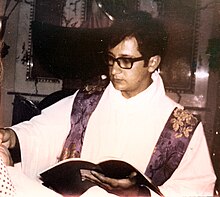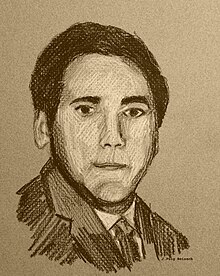Martyrs of La Rioja
This article needs additional citations for verification. (June 2018) |
Carlos de Dios Murias | |
|---|---|
| Martyr | |
 Murias presiding over a baptism. | |
| Church | Catholic Church |
| Diocese | La Rioja |
| Orders | |
| Ordination | 17 December 1972 by Enrique Angelelli |
| Rank | Priest |
| Personal details | |
| Born | Carlos de Dios Murias 10 October 1945 |
| Died | 18 July 1976 (aged 30) Chamical, La Rioja, Argentina |
| Nationality | Argentinian |
| Denomination | Catholic |
| Sainthood | |
| Feast day | 17 July |
| Venerated in | Catholic Church |
| Beatified | 27 April 2019 La Rioja, Argentina by Cardinal Giovanni Angelo Becciu |
Gabriel Longueville | |
|---|---|
 Fr. Longueville in Argentina. | |
| Church | Catholic Church |
| Diocese | La Rioja |
| Orders | |
| Ordination | 29 June 1957 by Alfred Couderc |
| Rank | Priest |
| Personal details | |
| Born | Gabriel Longueville 18 March 1931 |
| Died | 18 July 1976 (aged 45) Chamical, La Rioja, Argentina |
| Nationality | French |
| Denomination | Catholic |
| Sainthood | |
| Feast day | 17 July |
| Venerated in | Catholic Church |
| Beatified | 27 April 2019 La Rioja, Argentina by Cardinal Giovanni Angelo Becciu |
Wenceslao Pedernera | |
|---|---|
 | |
| Martyr | |
| Born | 28 September 1936 Los Jagüeles, La Calera, San Luis, Argentina |
| Died | 25 July 1976 (aged 39) Sañogasta, Chilecito, La Rioja, Argentina |
| Venerated in | Catholic Church |
| Beatified | 27 April 2019, La Rioja, Argentina by Cardinal Giovanni Angelo Becciu |
| Feast | 17 July |
Carlos de Dios Murias, OFM Conv. (10 October 1945 – 18 July 1976) and his two companions Gabriel Longueville (18 March 1931 – 18 July 1976) and Wenceslao Pedernera (28 September 1936 – 25 July 1976) were two priests and a married man who were killed in the La Rioja province in Argentina. Murias was a professed member from the Order of Friars Minor Conventual and Longueville was a priest incardinated in the Viviers diocese in France before moving to Argentina where he was incardinated into the La Rioja diocese. The two worked together in a La Rioja parish before their deaths while Pedernera, who served as a lay catechist,[1] was married with three daughters and was slain in front of them.[2][3][4]
Murias studied
The beatification for the three men was initiated in 2010 and in 2011 received the critical support of
Background
Carlos de Dios Murias was a professed member from the Order of Friars Minor Conventual who was killed alongside the French priest Gabriel Longueville who both worked in the same parish in La Rioja after transferring from the Viviers diocese. Wenceslao Pedernera was a married man who had three daughters. Murias and Longueville were tortured and killed together in Chamical while Pedernera was killed in front of his wife and children.
The trio were murdered in
In March 2013 both Juan Carlos Romero and Angel Pezzeta were sentenced to life imprisonment for their part in the murder of Murias and Longueville.[3]
Biographies
Carlos de Dios Murias
Carlos de Dios Murias was born on 10 October 1945 in
In his adolescence he first met and became close with Enrique Angelelli who served as the Bishop of La Rioja. He requested that Angelelli
Murias developed ties with - but never was a member - the
He tended to the poor in La Rioja and had a passion for being able to help them and the underprivileged people living in La Rioja. He was stationed together with the French priest Gabriel Longueville in a small parish church. Jorge Rafael Videla soon launched a coup and managed to gain control over the nation leading to increased violence and religious persecution. Murias's patron and mentor Angelelli was an outspoken critic of the regime as was Murias to a lesser extent.[2] But Murias soon attracted the attention of the authorities with an intelligence officer stationed at their air base monitoring his homilies and those of Loungeville. In Easter week in 1976 he had been summoned at midnight to the Chamical air base (under the direction of General Luciano Benjamín Menéndez) where he was questioned for four hours. One of the soldiers told Murias that the Catholic Church "is not a Church we believe in".[4][3] On 18 July 1976 he presided over a Mass at the chapel in the Santa Barbara church and said to his congregation: "Please, brothers, pray for us, we've been threatened and they're looking for us". This was when Angelelli began to fear for Murias and had instructed him to go to Rome so he would be safe. Murias promised the bishop that he would do so in September but he decided to remain in La Rioja so as to help defend the rights of farmhands who claimed parcels of land from radicalized landowners who were part of a corrupt movement.
In the evening on 18 July soldiers came to their apartment at the back of the
Bishop Angelelli celebrated over the dual funeral of Murias and Longueville.
Gabriel Longueville
Gabriel Longueville was born in
The pair were tortured and shot dead. His remains were discovered alongside Murias in the middle of a field on Route 38 after rail workers stumbled upon the remains. Both had plastic in their mouths and his hands were handcuffed.[2] The Bishop of Viviers Hermil learnt of his death and travelled to the site Longueville's remains were found in order to kiss the ground and plant grains of wheat from Longueville's village as a mark of respect.
Wenceslao Pedernera
Wenceslao Pedernera was born on 28 September 1936 in La Calera. He married Marta Ramona Cornejo - nicknamed "Coca" - on 24 March 1962. The couple had three daughters together and in June 1973 relocated to La Rioja where he began working on a farm. He had first met his wife in June 1961 but Cornejo's father disapproved of their relationship. The pair married in Mendoza in the San Isidro Labrador church. Pedernera organized the Movimento Rural Catolico movement that was dedicated to social activism and addressed a range of social concerns for workers and farmers. On 25 July 1976 four hooded and armed men burst into his house and gunned him down with 20 shots in front of his wife and daughters.
Beatification process
In 2010 the Bishop of La Rioja Roberto Rodríguez announced that the diocese was taking steps that could lead to the beatification process for the three men. In 2011 the Cardinal
The diocesan process was launched in La Rioja on 31 May 2011 and the Bishop of La Rioja
The current postulator for this cause is the Conventual Franciscan priest Damian-Gheorghe Pătraşcu.[citation needed]
References
- ^ a b c d "Beatification of four modern martyrs to the faith in Argentina - Vatican News". 27 April 2019.
- ^ a b c d e f g Day, Michael (19 March 2013). "Young Franciscan friar killed by the military during Argentina's Dirty War could become first beatified person under Pope Francis' reign". The Independent. Retrieved 12 May 2018.
- ^ a b c d e f Larraqy, Marcelo (20 March 2013). "The priest who Pope Francis wants to beatify". Clarín. Retrieved 12 May 2018.
- ^ a b c d e "Argentinean dictatorship victim could be first figure to be beatified by Pope Francis". La Stampa. 19 March 2013. Retrieved 12 May 2018.
- ^ Merolla, Daniel (20 March 2013). "Pope backed canonization process for slain priests". ABS-CBN News. Agence France-Press. Retrieved 12 May 2018.
- ^ "Promulgation of Decrees of the Congregation for the Causes of Saints, 09.06.2018" (Press release). Holy See Press Office. 9 June 2018. Retrieved 9 June 2018.
